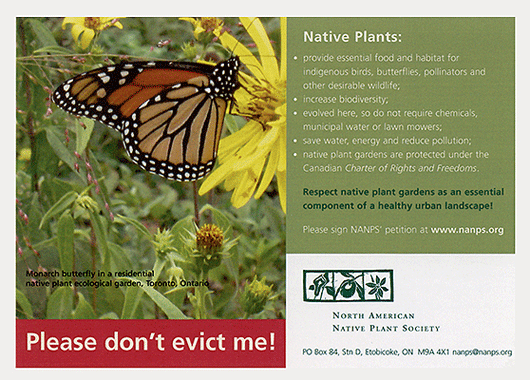October 2009 - The Age of Entitlement
The Toronto Green Plan
This is not a diatribe about the sorry state of civility, of performing all manner of wanton, daily ablutions in public, including the airing of dirty laundry, so evident in conjunction with the proliferation of "reality" shows. This is about throwing down the gauntlet and asserting our rights enshrined in the Law of the Land. Native plant gardens are still under attack. Why are our gardens treated as second-class citizens?
This is not really a failure to communicate. Something appears to be lost in translation. So NANPS would like you to send a message to City Hall...
The intent is there in paper form. The problem is translating it to reality. Here's some background with selected portions gleaned from a noble report. Check out the NANPS postcards below. If you didn't pick any up at the AGM, email nanps.org to arrange to get some. Even if you are not a resident of Toronto, send the card. Besides, it is still a good idea to follow the proceedings, as garden annihilation is probably going on in your neighbourhood, too.
In Toronto's first-ever, Environmental Plan: Clean, Green and Healthy - A Plan for an Environmentally Sustainable Toronto, The Final Report of the Environmental Task Force (ETF) February 2000 was submitted. Below are a few choice bits that are particularly relevant.
Page 18
3.0 A Vision of a Sustainable Future:
“The municipal government is a leader in protecting the environment, and sets an example through its corporate environmental policies. It works in partnership with businesses, institutions, other agencies and the public to achieve environmental health. City residents consider themselves stewards of Toronto's natural resources, and care passionately about its air quality, greenspace system, wildlife and water resources."
Page 98
Appendix A - Consolidated Recommendations
(4) Develop a Natural Heritage Strategy:
b) identify opportunities to create or enhance linkages between greenspaces and greenway corridors;
c) identify opportunities and priorities for environmental restoration and stewardship initiatives;
e) identify opportunities for partnerships with landowners, school boards and community groups.
Page 112
Appendix A - Education and Awareness,
42) Develop a Public Education and Outreach Program on the Environment and Sustainability boards and community groups:
(d) use a two-tiered community-based social marketing approach that develops broad public awareness of environmental conditions and issues and promotes individual behaviour change and the adoption of environmentally sustainable practices;
(e) include an “inreach" component aimed at City staff.
The plan ultimately morphed into The City of Toronto Green Guide of 2006. Under the Healthy Yards Program, “the goal is to attract desirable wildlife and create a healthy environment for families and neighbours." The program is administered by TRCA.
Taken all together, the intent was to include citizens in the solution by inviting them to take responsibility for their surroundings. The report infers that residents could make a difference by linking greenspaces, i.e., by gardening sustainably, i.e., by native plant gardening. Interestingly, the first report mentions educating City staff. Might that include a select bunch of perennial hardheads (Acroptilon repens) at ML&S? Alas, some nuts are hard to crack.
Scoop's Recommendation: Declare native plants as refugees, protected under IRPA (Immigration and Refugee Protection Act). By the time the rest of the world (=City of Toronto) catches up to our progressive thinking, which is about the time a century plant (Agave sp.) might bloom here, the native plants would have exhausted all avenues of appeal and been declared full-fledged citizens (and we would have revoked the sponsorship of exotic plant species).


(from The Local Scoop October 2009)


